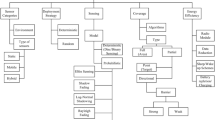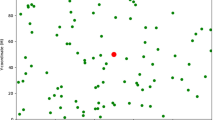Abstract
In most scenarios of wireless sensor networks (WSNs), different traffic types have specific service requirements. None of the previous MAC schemes has been able to provide true pre-emption to the high priority data. This paper introduced a novel data fragmentation scheme for low priority traffic in order to improve the delay performance of high priority traffic in WSN. It is proposed that instead of transmitting the low priority packet as a single unit, it should be transmitted in small fragments with pauses. A MAC protocol FROG-MAC has been designed based on the proposed fragmentation scheme. Simulations over Contiki operating system and testbed experiments over TelosB/Tmote Sky Platform have been performed to evaluate performance of FROG-MAC based on parameters of delay and throughput/packet delivery ratio (PDR). It has been found that FROG-MAC improves the delay and throughput of urgent traffic by reducing its waiting time. For increase in the fragment size, the delay of urgent traffic increases, whereas that of normal traffic reduces. With the increasing network size, the delay for both traffic types increases, and PDR reduces due to the increased network traffic load, collision and retransmissions. The performance of FROG-MAC has also been compared against energy-efficient multi-constrained QoS aware MAC.






























Similar content being viewed by others
References
Pirbhulal, S., Zhang, H., Alahi, M. E., Ghayvat, H., Mukhopadhyay, S., Zhang, Y.-T., et al. (2017). A novel secure IoT-based smart home automation system using a wireless sensor network. Sensors, 17, 69.
Henna, S. M. S., Bashir, F., Asfand-e-Yar, M., & Tauqir, M. (2017). A fair contention access scheme for low-priority traffic in wireless body area networks. Sensors, 17, 1931.
Pule, M., Yahya, A., & Chuma, J. (2017). Wireless sensor networks: A survey on monitoring water quality. Journal of Applied Research and Technology, 15, 562–570.
Qiu, T., Chen, N., Li, K., Qiao, D., & Fu, Z. (2017). Heterogeneous ad hoc networks: Architectures, advances and challenges. Ad Hoc Networks, 55, 143–152.
Rao, J. S., & Syamala, M. (2017). Internet of Things (IoT) based smart city architecture and its applications. International Journal of Computer and Mathematical Sciences, 6, 68–73.
Knieps, G. (2017). Internet of Things and the economics of smart sustainable cities. Competition and Regulation in Network Industries, 18, 115–131.
Zhang, C., Wang, Y., Liang, Y., Shu, M., & Chen, C. (2016). An energy-efficient MAC protocol for medical emergency monitoring body sensor networks. Sensors, 16, 385.
Ozen, Y., & Bayilmis, C. (2017). urgMAC: A new traffic and QoS-aware cross-layer MAC protocol for wireless multimedia sensor networks. The Computer Journal, 61, 1460–1467.
Donmez, M. Y., Isik, S., & Ersoy, C. (2014). Analysis of a prioritized contention model for multimedia wireless sensor networks. ACM Transactions on Sensor Networks (TOSN), 10, 1–31.
Yaghmaee, M. H., & Adjeroh, D. A. (2009). Priority-based rate control for service differentiation and congestion control in wireless multimedia sensor networks. Computer Networks, 53, 1798–1811.
Doudou, M., Djenouri, D., Barcelo-Ordinas, J. M., & Badache, N. (2016). Delay-efficient MAC protocol with traffic differentiation and run-time parameter adaptation for energy-constrained wireless sensor networks. Wireless Networks, 22, 467–490.
Nasser, N., Karim, L., & Taleb, T. (2013). Dynamic multilevel priority packet scheduling scheme for wireless sensor network. IEEE Transactions on Wireless Communications, 12, 1448–1459.
Quintero, V. L., Estevez, C., Orchard, M. E., & Pérez, A. (2018). Improvements of energy-efficient techniques in WSNs: A MAC-protocol approach. EEE Communications Surveys & Tutorials, 21(2), 1188–1208.
Sharma, H., Haque, A., & Jaffery, Z. A. (2019). Maximization of wireless sensor network lifetime using solar energy harvesting for smart agriculture monitoring. Ad Hoc Networks, 94, 101966.
Aissa, Y. B., Bachir, A., Khalgui, M., Koubaa, A., Li, Z., & Qu., T. (2019). On feasibility of multichannel reconfigurable wireless sensor networks under real-time and energy constraints. IEEE Transactions on Systems, Man, and Cybernetics: Systems, 1–16.
La Rosa, R., Livreri, P., Trigona, C., Donato, L. D., & Sorbello, G. (2019). Strategies and techniques for powering wireless sensor nodes through energy harvesting and wireless power transfer. Sensors, 12, 2660.
Loreti, P., Catini, A., Luca, M. D., Bracciale, L., Gentile, G., & Natale, C. D. (2019). The design of an energy harvesting wireless sensor node for tracking pink iguanas. Sensors, 19(5), 985.
Yuan, D., Zheng, G., Ma, H., Shang, J., & Li, J. (2019). An adaptive MAC protocol based on IEEE802. 15.6 for wireless body area networks. Wireless Communications and Mobile Computing, 2019, 1–9.
Bou Dargham, N., Makhoul, A., Abdo, J. B., Demerjian, J., & Guyeux, C. (2018). Efficient hybrid emergency aware MAC protocol for wireless body sensor networks. Sensors, 18(10), 3572.
Khan, A., Ghani, S., & Siddiqui, S. (2018). A preemptive priority-based data fragmentation scheme for heterogeneous traffic in wireless sensor networks. Sensors, 18(12), 4473.
Bhandari, S., & Moh, S. (2019). A MAC protocol with dynamic allocation of time slots based on traffic priority in wireless body area networks. International Journal of Computer Networks & Communications (IJCNC), 11, 25–41.
Moulik, S., Misra, S., & Das, D. (2017). AT-MAC: Adaptive MAC-frame payload tuning for reliable communication in wireless body area networks. IEEE Transactions on Mobile Computing, 16(6), 1516–1529.
Rasheed, M. B., Javaid, N., Imran, M., Khan, Z. A., Qasim, U., & Vasilakos, A. (2017). Delay and energy consumption analysis of priority guaranteed MAC protocol for wireless body area networks. Wireless Networks, 23(4), 1249–1266.
Nepal, S., Pudasani, A., & Shin, S. (2017). A fast channel assignment scheme for emergency handling in wireless body area networks. Sensors, 17(3), 477.
Pandit, S., Sarker, K., Razzaque, M. A., & Sarkar, A. J. (2015). An energy-efficient multiconstrained QoS aware MAC protocol for body sensor networks. Multimedia Tools and Applications, 74, 5353–5374.
Shen, W., Zhang, T., Barac, F., & Gidlund, M. (2014). PriorityMAC: A priority-enhanced MAC protocol for critical traffic in industrial wireless sensor and actuator networks. IEEE Transactions on Industrial Informatics, 10, 824–835.
Isaev, E. A., Tarasov, P. A., & Detkov, G. V. (2019). The utilization of modern technologies of wireless sensor networks in medicine. Journal of Physics: Conference Series, 2019, 1–4.
Martinez, B., Cano, C., & Vilajosana, X. (2019). A square peg in a round hole: The complex path for wireless in the manufacturing industry. IEEE Communications Magazine, 57(4), 109–115.
Ullah, S., & Kwak, K. S. (2012). An ultra low-power and traffic-adaptive medium access control protocol for wireless body area network. Journal of Medical Systems, 36, 1021–1030.
Ye, W., Silva, F., & Heidemann, J. (2006). Ultra-low duty cycle MAC with scheduled channel polling. In ACM proceedings of the 4th international conference on embedded networked sensor systems.
Siddiqui, S., Ghani, S., & Khan, A. A. (2018). ADP-MAC: An adaptive and dynamic polling-based MAC protocol for wireless sensor networks. IEEE Sensors Journal, 18(2), 860–874.
Author information
Authors and Affiliations
Contributions
AAK: Conducted the experiments, collected results, conducted analysis and comparison of findings. SS: Wrote the major sections of article. SG: Supervised the research.
Corresponding author
Ethics declarations
Conflict of interest
There is no conflict of interest among the authors.
Availability of Data and Materials
Experimental data will be made available.
Code Availability
Code will be made available over GitHub.
Additional information
Publisher's Note
Springer Nature remains neutral with regard to jurisdictional claims in published maps and institutional affiliations.
Rights and permissions
About this article
Cite this article
Khan, A.A., Siddiqui, S. & Ghani, S. FROG-MAC: A Fragmentation Based MAC Scheme for Prioritized Heterogeneous Traffic in Wireless Sensor Networks. Wireless Pers Commun 114, 2327–2361 (2020). https://doi.org/10.1007/s11277-020-07479-9
Published:
Issue Date:
DOI: https://doi.org/10.1007/s11277-020-07479-9




